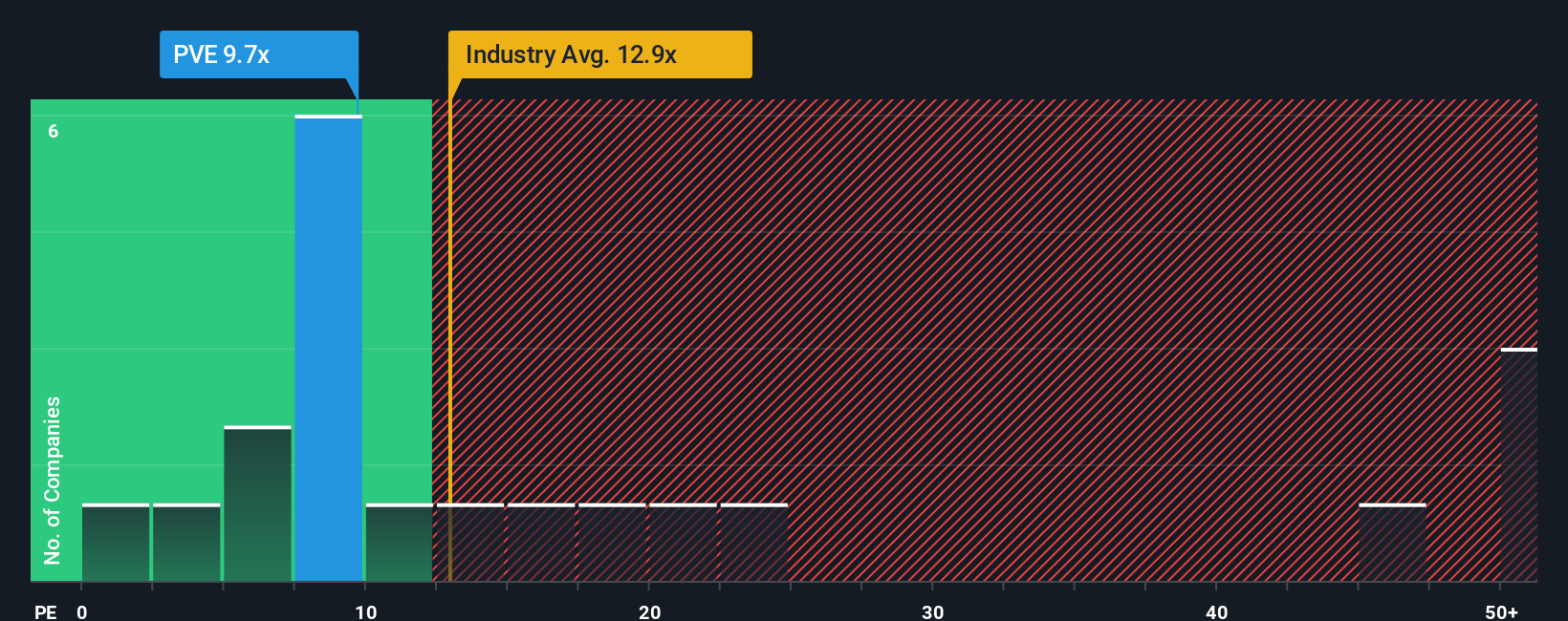- Australia
- /
- Oil and Gas
- /
- ASX:PVE
Po Valley Energy Limited (ASX:PVE) Looks Inexpensive But Perhaps Not Attractive Enough
With a price-to-earnings (or "P/E") ratio of 9.7x Po Valley Energy Limited (ASX:PVE) may be sending very bullish signals at the moment, given that almost half of all companies in Australia have P/E ratios greater than 22x and even P/E's higher than 41x are not unusual. Although, it's not wise to just take the P/E at face value as there may be an explanation why it's so limited.
With earnings growth that's superior to most other companies of late, Po Valley Energy has been doing relatively well. It might be that many expect the strong earnings performance to degrade substantially, which has repressed the P/E. If not, then existing shareholders have reason to be quite optimistic about the future direction of the share price.
View our latest analysis for Po Valley Energy

Is There Any Growth For Po Valley Energy?
Po Valley Energy's P/E ratio would be typical for a company that's expected to deliver very poor growth or even falling earnings, and importantly, perform much worse than the market.
If we review the last year of earnings growth, the company posted a terrific increase of 68%. Although, its longer-term performance hasn't been as strong with three-year EPS growth being relatively non-existent overall. So it appears to us that the company has had a mixed result in terms of growing earnings over that time.
Shifting to the future, estimates from the only analyst covering the company suggest earnings growth is heading into negative territory, declining 3.9% per year over the next three years. Meanwhile, the broader market is forecast to expand by 18% per year, which paints a poor picture.
In light of this, it's understandable that Po Valley Energy's P/E would sit below the majority of other companies. However, shrinking earnings are unlikely to lead to a stable P/E over the longer term. There's potential for the P/E to fall to even lower levels if the company doesn't improve its profitability.
The Final Word
While the price-to-earnings ratio shouldn't be the defining factor in whether you buy a stock or not, it's quite a capable barometer of earnings expectations.
We've established that Po Valley Energy maintains its low P/E on the weakness of its forecast for sliding earnings, as expected. Right now shareholders are accepting the low P/E as they concede future earnings probably won't provide any pleasant surprises. Unless these conditions improve, they will continue to form a barrier for the share price around these levels.
And what about other risks? Every company has them, and we've spotted 2 warning signs for Po Valley Energy (of which 1 shouldn't be ignored!) you should know about.
Of course, you might also be able to find a better stock than Po Valley Energy. So you may wish to see this free collection of other companies that have reasonable P/E ratios and have grown earnings strongly.
New: Manage All Your Stock Portfolios in One Place
We've created the ultimate portfolio companion for stock investors, and it's free.
• Connect an unlimited number of Portfolios and see your total in one currency
• Be alerted to new Warning Signs or Risks via email or mobile
• Track the Fair Value of your stocks
Have feedback on this article? Concerned about the content? Get in touch with us directly. Alternatively, email editorial-team (at) simplywallst.com.
This article by Simply Wall St is general in nature. We provide commentary based on historical data and analyst forecasts only using an unbiased methodology and our articles are not intended to be financial advice. It does not constitute a recommendation to buy or sell any stock, and does not take account of your objectives, or your financial situation. We aim to bring you long-term focused analysis driven by fundamental data. Note that our analysis may not factor in the latest price-sensitive company announcements or qualitative material. Simply Wall St has no position in any stocks mentioned.
About ASX:PVE
Po Valley Energy
Operates as a gas and condensate development company in the Po Valley Region, Italy.
Flawless balance sheet with solid track record.
Similar Companies
Market Insights
Community Narratives




